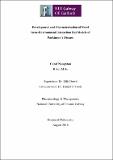| dc.description.abstract | Despite its discovery almost 60 years ago, levodopa remains the most effective therapy for the treatment of the motor symptoms associated with Parkinson’s disease. However, chronic use of levodopa is associated with serious side effects such as the emergence of dyskinesias, on-off effects and is also limited by the fact that it is purely symptomatic and does not slow progression of the disease. One of the reasons suggested for the paucity of disease-modifying therapies for Parkinson’s disease is the lack of relevant animal models which reliably recapitulate the features of the human disease. To date, Parkinson’s disease has been modelled extensively in preclinical animals using selective catecholaminergic neurotoxins such as 6-hydroxydopamine and MPTP, and is typically induced using a single insult. Unfortunately, these models bear little etiological resemblance to the human condition as Parkinson’s disease is thought to arise as a result of complex interactions between underlying genetics and exposure to environmental factors. Therefore, the overarching aim of this project was to develop a novel model of Parkinson’s disease incorporating both genetic and environmental exposures. Not only would this shed further light on relevant gene-environments interactions in the context of the etiology of Parkinson’s disease, but would also provide a novel gene-environment model for testing potential neuroprotective and disease-modifying therapies for this condition.
In order to facilitate development of a novel gene-environment model, we first characterised the motor and neuropathological impairments induced by the Parkinson’s disease-associated pesticide, rotenone, and the bacterial inflammagen,
Lipopolysaccharide (LPS) and compared them directly to those induced by the ‘gold standard’ catecholamine neurotoxin, 6-OHDA. We then went on to assess the impact of dual exposure of rats to overexpression of the Parkinson’s disease-associated protein, -synuclein, and bacterial-like neuroinflammation and neurodegeneration driven by LPS. Finally, we investigated the impact of -synuclein overexpression in combination with the agritoxin-driven Parkinsonism induced by rotenone. With the single lesion models induced by 6-OHDA, rotenone and LPS, we found that despite similar levels of neurodegeneration, the neurotoxic, environmental and bacterial triggers induced distinctly different patterns of motor dysfunction. With the dual exposure gene-environment studies, we found that exposing rats to both AAV--synuclein and LPS did not exacerbate the Parkinsonism caused by either toxin alone. In contrast, dual exposure to AAV--synuclein and rotenone significantly exacerbated the level of motor dysfunction and neurodegeneration caused by the genetic or environmental factor alone.
Overall, this research has shown that different Parkinson’s disease-related neurotoxins can induce different patterns of motor dysfunction indicating the importance of the choice of lesioning agent in preclinical Parkinson’s disease studies. We have also shown that dual exposure of rats to overexpression of the Parkinson’s disease-associated protein, -synuclein, and the Parkinson’s disease-associated pesticide, rotenone, induced a highly relevant rat model of the condition with improved etiological relevance over existing models. Thus, this model may provide a suitable platform for testing novel neuroprotective and disease-modifying therapies for this condition. | en_IE |


